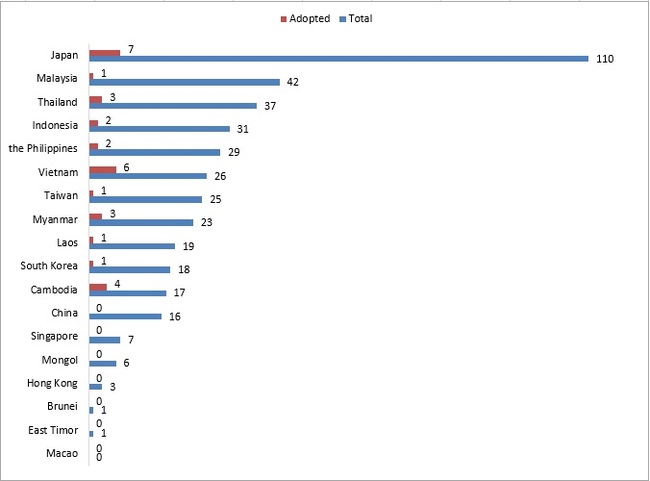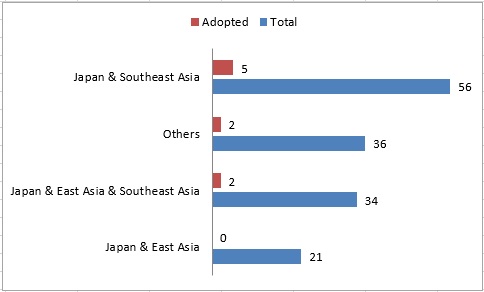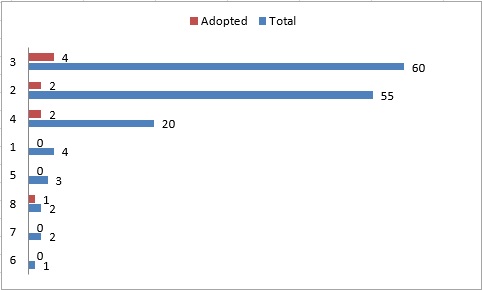Selection Committee Chair Prof. Shigeto Sonoda
Outline of Fiscal 2019 International Grant Program “Cultivating Empathy Through Learning from Our Neighbors: Practitioners’ Exchange on Common Issues in Asia”
Since the foundation in 1974, the Toyota Foundation has been providing large amount of grants to Southeast Asian countries. Since the Asian Neighbors Program was initiated in fiscal 2009, the foundation has called for applications and provided financial support to the projects aiming to solve issues that Asian countries are facing. The program was renamed the International Grant Program in fiscal 2013. Grants were provided to policy-proposing projects with sights set on the future of Asia before fiscal 2015, but since then, the foundation has been supporting projects which try to tackle common issues in Asia through exchange and mutual learning. The basic foundations of the International Grant Program 2019 were established in the course of these continuous efforts.
The Toyota Foundation has discussed the principle of emphasizing grant programs since the previous fiscal year. The prioritized area (Area A) of the International Grant Program is on projects required to promote “Multicultural Inclusion in Communities,” and diverse related proposals are to be reorganized as the Open Field (Area B).
The foundation has set five grant policies; they are 1. Great significance for society, 2. Anticipating internal and external issues, 3. Future-oriented, 4. Sustainable and developable, and 5. Expected to have a ripple effect. Based on these policies, the foundation has highlighted four elements specific to international grant programs since last year so that the applicants can easily understand the desirable requirements for the proposed projects. This fiscal year continues to adopt the same elements as well as the same total budget.
(1) Transnationality: Whether the proposed project covers at least two East or Southeast Asian countries or regions, and project members are from at least two countries or regions. The project is to bring about results or effects in multiple countries.
(2) Cross sectoral approach: Whether the specialists (e.g. researchers, activists, and civil service in charge) are systematically involved and participate in the proposed project.
(3) Mutual learning: Whether participants have established relationships for mutual learning during the implementation of the proposed project.
(4) Foresight: Whether the proposed project addresses overtly or covertly important issues, is highly conscious of its outcomes, and has prospects for further development.
There is one point that is different from previous years. That is, the proposed project was expected to have a representative whose main residence is located in Japan. The goal of this change was to allow representatives of projects to communicate more closely with the Toyota Foundation in different phases of the project management; that is, before, during and after the awarding of grants (close communication is one of the requirements for candidates), but the change has greatly affected the number and the contents of the applications as will be described below.
Overview of Applications
There were 147 applications in fiscal 2019, reflecting a continuation of the recent trend of reduced applications in number (328 in fiscal 2017, 242 in fiscal 2018).
The tendency can be traced if we look at the changes in thematic areas and the characteristics of project representatives.
In terms of the thematic areas, 54 applications were in Area A (37%) and 93 applications were in Area B (63%). In other words, two thirds of applications corresponded to the Open Field. In the previous fiscal year, 130 applications were made for the Non-open Field (roughly corresponding to current Area A). Obviously, there was a drastic decrease in applications in this area.
The distribution of the nationalities of project representatives also changed: the ratio of Japanese representatives doubled, increasing from 36% in the previous year to 71% this year. Looking closely at the reduced number of applications made from countries other than Japan, we can find that the number of applicants from Southeast Asian countries dropped dramatically: 24 dropped to 9 from Malaysia, 18 to 8 from Indonesia, and 17 dropped to just 2 from the Philippines. There was only one application from the U.S.A. (9 in the previous fiscal year) and none from China (4 in the previous fiscal year). The number of proposals from those countries, which used to have many applicants, also decreased significantly.
The declining number of applications from Southeast Asian and other countries in the Non-open Field was caused by the new requirement that representatives of projects should have their main residence in Japan. Conversely, more proposals for projects targeted Japan than before. Figure 1 lists the countries or regions where projects are to be implemented as stated in application forms. The figure shows that 76%, roughly three quarters of all applications, are intended to be implemented in Japan.
Fig. 1: Targeted countries / regions that were stated in application forms
(Excluding other than East Asia and Southeast Asia)

Consequently, some changes were witnessed in terms of the combination of countries or regions that projects targeted. The number of projects targeting Japan and Southeast Asia was 56, exceeding the number of projects targeting countries and regions other than Japan (see Fig. 2). Thirty-four proposals were targeting Japan, East Asia, and Southeast Asia, though these combinations are the most difficult to manage.
Fig. 2: Combination of targeted countries / regions that were stated in application forms
(Excluding other than East Asia and Southeast Asia)

It is thus understandable that not so many countries were targeted in a single project, considering the high transaction cost to fulfill the element of “mutual understanding” (See page 4) for the proposal. In fact, 115 projects targeted just two or three countries or regions, accounting for 78% of the proposed projects (see Fig. 3).
Fig. 3: The number of targeted countries / regions that were stated in application forms
(Excluding other than East Asia and Southeast Asia)

Selection Results
The selection committee was made up of four members including the committee chair. Two of them have continued in their positions from the previous fiscal year, while the remaining two were newly appointed.
Figure 3 shows that four applications are targeting a single country: obviously, these applications do not meet the first element of “transnationality” (See page 4). Three program officers (POs) first eliminated those applications which did not satisfy four elements before they asked each committee member to inspect the remaining applications.
At the next stage, the four committee members read the applications carefully and each recommended ten projects, considering the number of selected projects in previous years. Each member gave a weight on each of the projects that he or she recommended and added personal comments. If a member had any question about the proposal, he or she asked the applicant through the POs, who collected additional information from the applicants. The members of the selection committee tried to read all the applications including those which were eliminated by the POs.
At the end of the selection process, selection committee meeting was held after the review process was completed. They discussed each of the 22 applications that at least one of the members had recommended. Each member explained why he or she recommended or did not recommend the project. They discussed any disagreements and sought to select the projects fairly and objectively. Then, the members checked if each project corresponded to the thematic area the applicant had self-reported. They made the final decision, having considered all information collected by the POs and checked the balance between two thematic areas and among targeted countries or regions. Finally, nine projects were selected this fiscal year. As the low selection rate (6.1%) suggests, selection was very difficult.
The projects selected for fiscal 2019 have the following characteristics (see Figs. 1, 2 and 3).
Firstly, as many as seven out of nine selected projects are targeting Japan. Even the two projects that do not target Japan have Japanese representatives. In other words, the committee did not (or could not) select a project which was not related to Japan/Japanese. We must wait to see if this criteria of selecting projects was right or not until the selected projects will be completed.
Secondly, the number of selected projects targeting East Asia was only two (Taiwan: 1; Korea: 1), far less than those targeting Southeast Asia. There were no applicants from China, and there were no projects targeting China. It is a pity, considering China’s greater presence in Asia as well as from the fact that it is experiencing more and more of the same kinds of social problems found in other Asian countries.
And thirdly, in terms of the selected projects by thematic area, the rate of selection (33% in Area A and 67% in Area B) is roughly equal to the distribution of the applications. However, there were more appealing applications in Area B. It may be necessary to find the better ways to increase the number as well as the quality of the proposals for Area A in the future.
The number of adopted projects decreased from last year (11 projects) by two. This may be caused by the less appealing applications (especially in Area A) and fewer challenging proposals. Notably, two committee members continuing in position from the previous year mentioned that it was easier to select projects than before.
Introducing Adopted Projects
The following introduces a couple of projects which received relatively better evaluation by the committee members, one each for Area A and B (the countries in brackets show non-target countries of the International Grant Program).
1. Thematic Area A: Multicultural Inclusion in Communities
| Toshihiro Menju, Managing Dierctor, Japan Center for International Exchange |
| Guarantee of Adequate Information Provision in Transnational Migration - Toward a Realization of a Fair and Robust Migration |
| Target Countries and Regions: Japan, Korea, [Nepal], and Myanmar |
| Grant Period: two years |
| Grant Amounts: 8.0 million yen |
Mr. Toshihiro Menju, Managing Director and Chief Program Officer of the Japan Center for International Exchange, has been engaged in international exchange in Japan for many years. He proposed a very appealing project based on the center although it may seem low-profile.
In the usual migration of workers, there has been an overwhelming imbalance in information sharing. There have been such problems as the unjust invitation/mediation of workers, violation of employment rights, and a gap between required talents and job seekers’ skills as the underground activities of brokers suggest. The project aims to encourage specialists to cooperate with each other in Japan and Korea whose national governments are planning to accept more immigrants from other Asian countries and to make cooperative action plans together with experts and the organizations run by those who have experienced working abroad in the home countries of workers so that the immigrants from Nepal and Myanmar can enjoy fair treatment. It is an attempt to realize a guarantee of information accessibility for immigrants. Greater outcomes can be expected if cooperation with governmental sectors as well as other public organizations is possible, and outcomes can be shared in a creative manner.
2. Thematic Area B: Open Field
| Yuichi Tomohiro, Representative Director, General Incorporated Association TSUMUGIYA |
| Cultivating intermediate players who can coordinate local resources and creating a learning platform across countries/sectors through a designers’ residency program |
| Target Countries and Regions: Indonesia, Cambodia, Vietnam, Taiwan, [India], Thailand, Philippines, |
| Malaysia, and Japan |
| Grant Period: two years |
| Grant Amounts: 9.0 million yen |
Mr. Yuichi Tomohiro, head of NGO named Tsumugiya, submitted an ambitious proposal based on his own experience of having implemented the stay-based program called DOOR to ASIA (DTA) in Rikuzentakata, which was devastated by the Great East Japan Earthquake, from 2015 to 2018. The project aims to build a platform for mutual learning/assistance across activity fields/sectors/countries by sending young designers and mentors to specific regions to create charming products of appealing design based on understanding of the uniqueness of the region (and selling the products to external markets).
The organization has already accumulated a track record. A wide range of mutual learning can be expected because the participants in the past projects will also join the project, and they already have a broad network of cooperators around Asia. They are highly aware of the functions of “intermediate players” who can compensate for the shortcomings of the conventional model of endogenous development; thus, there is potential for future development.
Conclusion
The themes in the prioritized area for this fiscal year have been set in order to accept the proposals for concrete solutions for various problems caused by demographic changes in Asia (e.g. the issue of multicultural coexistence and other social issues caused by increasing number of foreign migrants which is triggered by different population pyramids in Asia). Regrettably some applicants seemed to have chosen wrong thematic area, possibly because of the ambiguous nuances of the Japanese explanations, compared with the more straightforward English expression. In addition, the number of applications in the prioritized area was small, which might be a reflection of the reality that the applicants in Japan may be less experienced in discussing and dealing with the issues of immigration and multicultural coexistence from the viewpoint of cooperation across Asia.
The selection committee fully realizes that proposals directly reflected what the representatives of the projects had done and experienced. It may be difficult for NPO staffs, who are busy managing daily activities, to convincingly explain about the significance of their project and its expected outcomes to a third party while researchers, who are well-trained in academic proposal writing, might have found it challenging to write an appealing application for the International Grant Program if they are not aware of concrete solutions for the issues they are researching. Hopefully, more people will overcome such difficulties and apply for the International Grant Program in the next fiscal year.
